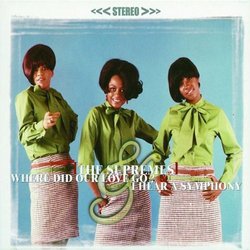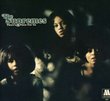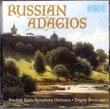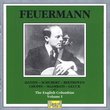| All Artists: Diana Ross & Supremes Title: Where Did Our Love Go / Hear a Symphony Members Wishing: 2 Total Copies: 0 Label: Universal UK Release Date: 1/22/2001 Album Type: Original recording remastered, Import Genres: Pop, R&B Styles: Oldies, Classic R&B, Motown, Soul Number of Discs: 1 SwapaCD Credits: 1 UPC: 766486548923 |
Search - Diana Ross & Supremes :: Where Did Our Love Go / Hear a Symphony
 | Diana Ross & Supremes Where Did Our Love Go / Hear a Symphony Genres: Pop, R&B
UK version of Motown's '2 Classic Albums On 1 CD Series'. Reissue of 'Where Did Our Love Go?' (1964) and 'I Hear a Symphony' (1966) together on 1 CD. Packaged in a full color slipcase with original artwork and 8 page bookl... more » |
Larger Image |
CD DetailsSynopsis
Album Description UK version of Motown's '2 Classic Albums On 1 CD Series'. Reissue of 'Where Did Our Love Go?' (1964) and 'I Hear a Symphony' (1966) together on 1 CD. Packaged in a full color slipcase with original artwork and 8 page booklet. The former, the group's debut Similar CDs
|
CD Reviews5, BUT ONLY FOR WHERE DID OUR LOVE GO VINCENT P TARSITANO | PORT ORANGE, FL USA | 04/05/2005 (5 out of 5 stars) "WHERE DID OUR LOVE GO is an excellent, excellent collection of music. The album reached #2 on the pop lp chart, and is reportedly the best selling POP album of 1964. That was a tremendous accomplishment for The Supremes and for Motown Records at the time. The Holland-Dozier-Holland writing and producing unit had hit its stride, if not its peak, at the time this music was released. They are represented with several of the tunes here, including 3 pop #1's [Where Did Our Love Go, Baby Love, Come See About Me], as well as the girls' first top 40 hit [When The Lovelight Starts...], which is somewhat of a Phil Spector soundalike, and is quite a production and performance. It also includes the classic H-D-H production/composition, "Ask Any Girl," which is one of the prototypes of symphonic soul, and features that incredible, and incredibly hummable "La-La-La" background by Mary Wilson and Florence Ballard. The very first H-D-H/Supremes collaboration, "I'm Giving You Your Freedom," which is a major gem, is also included. I particularly like the 2 Smokey Robinson-produced selections, "Long Gone Lover" and "A Breathtaking Guy." The former, a real soul-rocker, starts out with Mary's great alto part, and ends with an arresting, gospel-tinged tag by Florence, the latter featuring fill-in lines on the chorus by Florence and Mary, which gives an additional glimpse at "the other 2 singers'" glorious talent, which was squelched more and more as time went on in order to promote Diana Ross' supremacy within the group. In my opinion, it was an incredulously unfortunate move to suppress 2/3 of the group's talent, in spite of Diana's effective, exciting leads on so many classic hits. Anyway, an early Norman Whitfield effort is included, as well, and it is pretty stunning ["He Means The Word To Me"]. One of the very great treats on this album is a Robert Gordy production, "Your Kiss of Fire," which features absolutely knockout backing vocals, especially Flo's soprano part. Amazing! H-D-H's "Run, Run, Run" was meant to capitalize on the success of "Lovelight," and failed, in spite of it being an above-average early effort. Also, their "Standing At The Crossroads of Love," is a gem. That should account for all 12-tunes on this extraordinary set, which needs to be in any pop, r&b, Supremes, Motown, or early-mid 60's music enthusiast's collection. As for I HEAR A SYMPHONY: the title tune is one of Motown, The Supremes, and H-D-H's best. "Everything Is Good About You," is very beautiful, and is almost a Diana solo. "He's All I Got" and "Any Girl In Love" are above-average H-D-H productions. All of the cover tunes, though well produced, are uninspired. Diana's voice seems somewhat clunky on some of these tunes, and there is a suppressed sound to the background singing, when present. Here is a classic example of an album that had those good Motown intentions of expanding the artists' appeal, but that would most certainly have benefitted from including the "other 2 singers'" immense talent and contributions, which might have better suited certain songs. In spite of these shortcomings, The Supremes still had enough draw at this point for this effort to reach #8 pop. Note that the packaging of the above is quite interesting, featuring a slip case and novel jewel case. The booklet isn't anything special, just a few pictures and track annotations. Overall, a good buy, with WHERE DID OUR LOVE GO constituting absolutely ESSENTIAL Supremes. Also note that, via Hip-O-Select, and released in early 2005 in limited edition, is available a beautiful, deluxe 2 cd edition of WHERE DID OUR LOVE GO. It features lovely packaging and full-color booklet with copious notes and photos. Disc One contains BOTH mono and stereo versions of the album, from start to finish, and in that order. Disc Two contains many previously unreleased tunes that were either recorded during the WDOLG sessions, or during the same time period, a handful of which were probably worth releasing back then, and none of which feature lead vocals other than Diana's. It is a rather expensive deal at nearly $40. As a huge Supremes fan and near-completist, I sprung for it. Worth considering." The Beginning Of Supremes Mania Ian Phillips | Bolton, Lancashire, UK | 06/14/2006 (5 out of 5 stars) "To zoom in on The Supremes chart-topping success in 1964, Tamla Motown records (which they had been signed to since January 1961) released an accompanying album named after their first ever No.1 hit Where Did Our Love go. The Where Did Our Love Go album hosted a collection of their chart-toppers,a few minor hits from a time when they were referred to as "The No Hit Supremes" by fellow Motown colleagues (after having released nothing but a succession of flops and minor hits between 1961-63), B-Sides and a few would-be hits.
The swirling, latin-inspired, mellow arrangements on the divine A Breath Taking Guy had been penned by the genius song writing skills of Smokey Robinson (who Bob Dylan once described as "the greatest living poet"). The track featured a warm, sensual and passionate vocal performance from The Supremes stunning lead singer Diana Ross and contained magnificent vocal trade-offs on the shimmering chrous from The Supremes founder Florence Ballard and Mary Wilson. This should have been a break through for The Supremes (as should one of their earlier singles Your Heart Belongs To Me) but instead it stalled at No.75 on the Billboard Charts and yet even that was an improvement as their single prior to this, Let Me Go The Right Way, got as far as no.90! However their next recording When The Lovelight Starts Shining Through His Eyes packed a wallop like none of their other singles had to that point. It also marked the beginning of the legendary collaboration with Motowns hottest writers Holland-Dozier-Holland who along with Motowns unsung heroes, The Funk Brothers, helped define what was commonly known as "The Motown Sound - the sound of young America" but also helped develop an identity and focus for The Supremes where others most surprisingly such as smokey Robinson had failed. Containing an effective conga beat that generally had all the emphasis of that classic Tamla Motown sound, When The Lovelight Starts Shining Through His Eyes carried a strong and an unusually assertive performance from the magical Diana Ross who was now the groups permanent lead singer. Though indeed a classic, the track enjoyed only marginal chart success, climbing its way to No.23 on the Billboard charts but then this single had certainly made far more noise than any of their previous singles. Perharps cashing in on the success of The Crystals famous classic, Da Doo Ron Ron Ron, The Supremes next release was Run, Run, Run. Ross gallops along eagerly keeping up with the frentic, tight arrangements where as Ballard and Wilson enhance the production even further with their strong, effective backing vocals. Run, Run, Run has instant immediacy which is why its all the more surprising that Run, Run, Run crawled only to a dire No.93. the Supremes were confident after the top 30 success of When The Lovelight that they were on the right track to superstardom but the relative failure of Run, Run, Run dented their hopes. Holland-Dozier-Holland then offered Where Did Our Love Go to the now distraught Supremes after it had already been rejected by The Marvelettes (who helped put Motown on the map by delivering the labels first No.1 hit with Please Mr. Postman) and Mary Wells (famous of course for one of Motowns most definitive classics, My Guy). Lead singer of The Marvelettes, Gladys Horton labelled the song "junk" and to top it off The Supremes also hated the song, especially Mary Wilson who never believed the song was going to be a hit. How wrong could they have all been! Diana Ross oozed sensuality sounding sexy and angelic on Where Did Our Love Go whilst Ballard and Wilson provide the obligatory back up vocals throughout. Where Did Our Love Go caught on to the public like a magnet and it speedily found its way to pole position on the charts and was the first in a run of five consecutive no.1 hits. The Supremes had been travelling around the U.S on the Dick Clarke Caravan of stars appearing alongside such names as The Shirelles and Gene Pitney. The Supremes fell under the banner "and others" but after Where Did Our Love Go they were the HEADLINE attraction! Baby Love was even bigger where it topped the charts on both sides of the Atlantic. This marked the beginning of Supremes Mania. Baby Love was simply just three minutes of what was pure, utter perfection! Ross' exuberant delivery is so touchingly sweet and the warm backing harmonies of Ballard and Wilson merely add to that dazzling effect. Come See About Me swiftly followed Baby Love to the top of the charts. They were on a roll now! This was a more sassy offering (and my own personal favourite of their chart toppers of 1964) where Ross is joined in a capella at points by Ballard and Wilson that proved very effective. At this stage of the game, The Supremes sound was much more group oriented and didn't fully revolve around the distinct sound of Diana Ross. The remainder of the terrific Where Did Our Love Go album was all indeed top notch stuff thanks to the unique and distinct vocals of Diana Ross to great, impeccable song writing from Holland-Dozier-Holland and complex, superbly crafted musical arrangements from Motowns legendary in house band known as The Funk Brothers. Long Gone Lover sounded like another sure fire smash hit for The Supremes even though it remained just an album track. Those infectious musical arragements are enhanced by another sweet, tender lead by Diana Ross whilst the true volume and power of Florence Ballards far more earthy vocal style can be heard at the climax before the track fades out. I'm Giving You Your Freedom had been recorded back in 1963 and featured Ross singing in a higher, yet sharper vocal tone thats fittingly raw and solid. The track also features a beautifully understated guirtar interlude at the bridge of the song. The rather sugary Standing At The Crossroads Of Love features Ross singing again in a high key that becomes a little shrill at points but yet still proves adorable as it possessed such a unique and a very different quality. The sharp, inventive musical arrangements on He Means The World To Me is a perfect example of the girl group sound of the early 1960's with another vulnreable, angelic sounding Ross chirping away against the intricate backing vocals of Ballard and Wilson. The sweeping rhythm section on Your Kiss Of Fire has an exhilirating lead vocal performance from Ross but standing right next to I'm Giving You Your Freedom as a KNOCK OUT album track is Ask Any Girl. Ask Any Girl opens with a yearning vocal interlude from Ross which then pumps out into the classic Motown sound with lots of finger snapping and handclaps, repetitive beats and pulsating rhythms. Ross seamlessly surfboards along those glorious arrangements courtesy of The Funk Brothers. Ask Any Girl had been used as the B-Side to their cross-Atlantic no.1 hit Baby Love though easily could have become a hit in its own right. Where Did Our Love Go is a landmark album by Diana Ross and the Supremes and also became one of Motowns biggest ever selling albums spending a total of 89 weeks on the chart. ESSENTIAL! I Hear A Symphony (1965) is a different story. To broaden Diana Ross And The Supremes appeal to a multi-racial audience, Berry Gordy had the group record showbiz standards and cover tracks from the middle-of-the-road market. Berry Gordys mission was accomplished and soon Diana Ross And The Supremes were perceived as all-round entertainers. The I Hear A Symphony album is a pure example of what Berry Gordy accomplished with the group and whilst some say their startling and clearly inspired versions of showbiz classics like Stranger In Paradise, Without A Song and Wonderful, Wonderful, showcase their flair for diversity, I have to say purley from my own personal view that I found those kind of tracks quite ghastly. When I think of Diana Ross And The Supremes, I think Soul/R&B/Pop and its these elements of styles that captured their own unique, magical sound. There is a rather bland reading of The Beatles, Yesterday whilst there is little ignition in their ponderous cover of The Righteous Brothers, Unchained Melody. Diana Ross certainly makes the songs her own as she sings them in her own unique vocal style and in no way are these criticisms aimed at Diana Ross but I feel the corny showbiz and MOR cover versions flaw this album in a big way and no doubt other die-hard Soul/R&B fans like myself, ran for cover on hearing these recordings! However in its favour, and this alone justifies the reason for buying I Hear A Symphony, is the magnificent tracks that get that full injection of the riveting Motown sound. I Hear A Symphony is a pure masterpiece. A glossy, sophisticated soul number vastly containing elements of Jazz is coated by Diana's rich, golden voice.I Hear A Symphony became The Supremes sixth chart topper. Another outstanding masterpiece is the utterly dynamic and stunning My World Is Empty Without You where Diana puts in an almost stark and far more earthy sounding vocal performance and is all the more effective in doing so. It was on tracks like these that you realised the full extent and range of Diana Ross's vocal abilities that literally pour out on such fully-formed productions like these. My World Is Empthy Without You quickly flew into the U.S Top 5 (despite seemingly having all the momentum and fire to go all the way into pole position). More laid-back but still totally infectious is the lovely Any Girl In Love (Knows What I'm Going Through) whilst Everything Is Good About You basically has Motown written all over it! Though you could argue some tracks on Diana Ross And The Supremes full-length studio albums were somewhat formulaic, most individual recording still ecapsulated its own unique quality when judged on its own merits. Finally I Hear A Symphony closes with the fabulous Northern-soul vibes of He's All I Got where there shimmering harmonies blend fantastically well together and He's All I Got in my opinion rates as one of their very best album recordings and most certainly has a strong commercial flair. On the whole I Hear A Symphony is memroable purley on the tracks that are ignited by that riveting Motown effect but the showbiz covers sound dated that have not comfortably stood the test of time. Contrary to my own personal perception of the showbiz recordings, some fans will argue that these remain some of Diana Ross' most enthralling work and that I Hear A Symphony is one of their best studio albums, so its defintley worth a listen all-round. " |

 Track Listings (24) - Disc #1
Track Listings (24) - Disc #1






